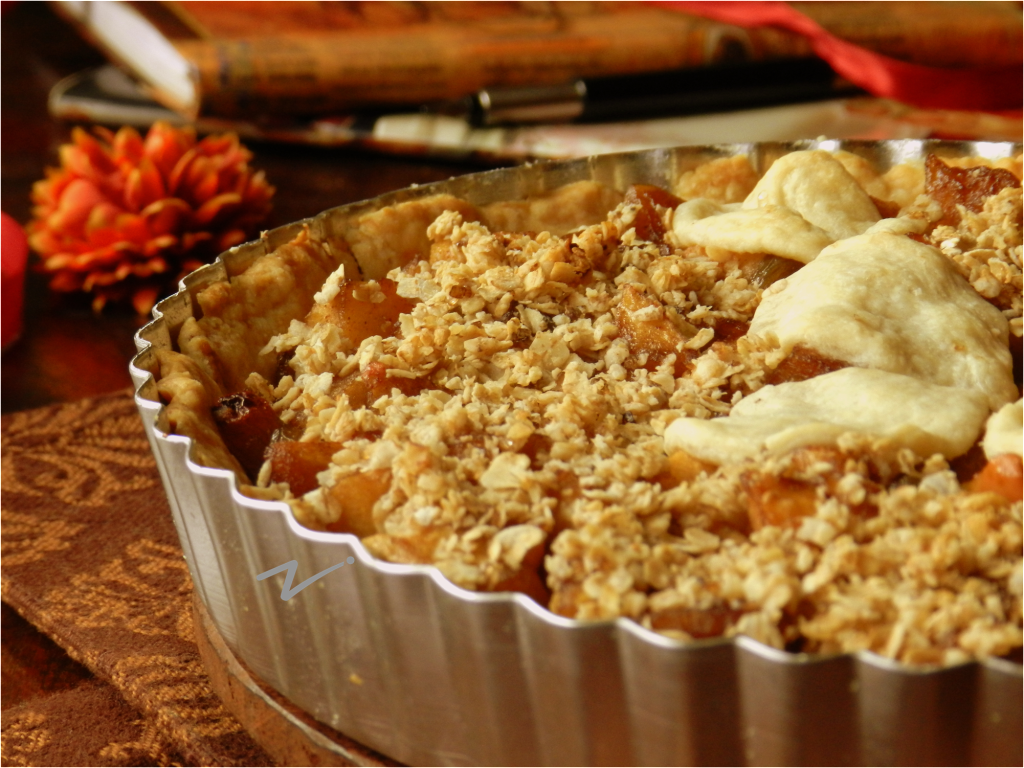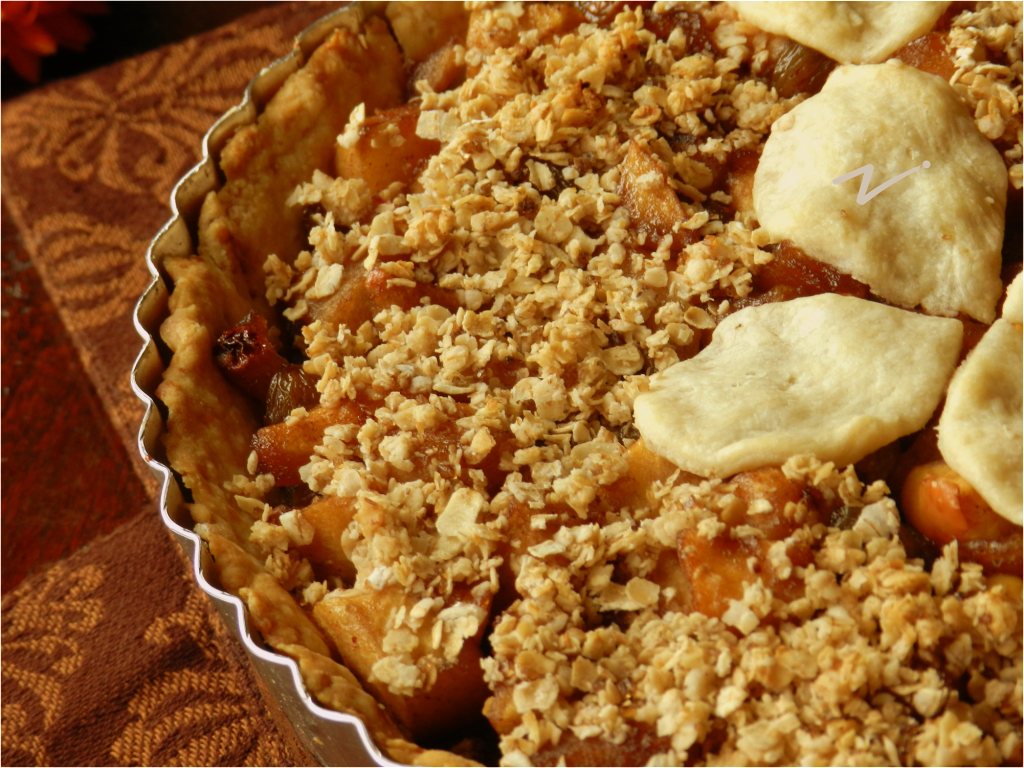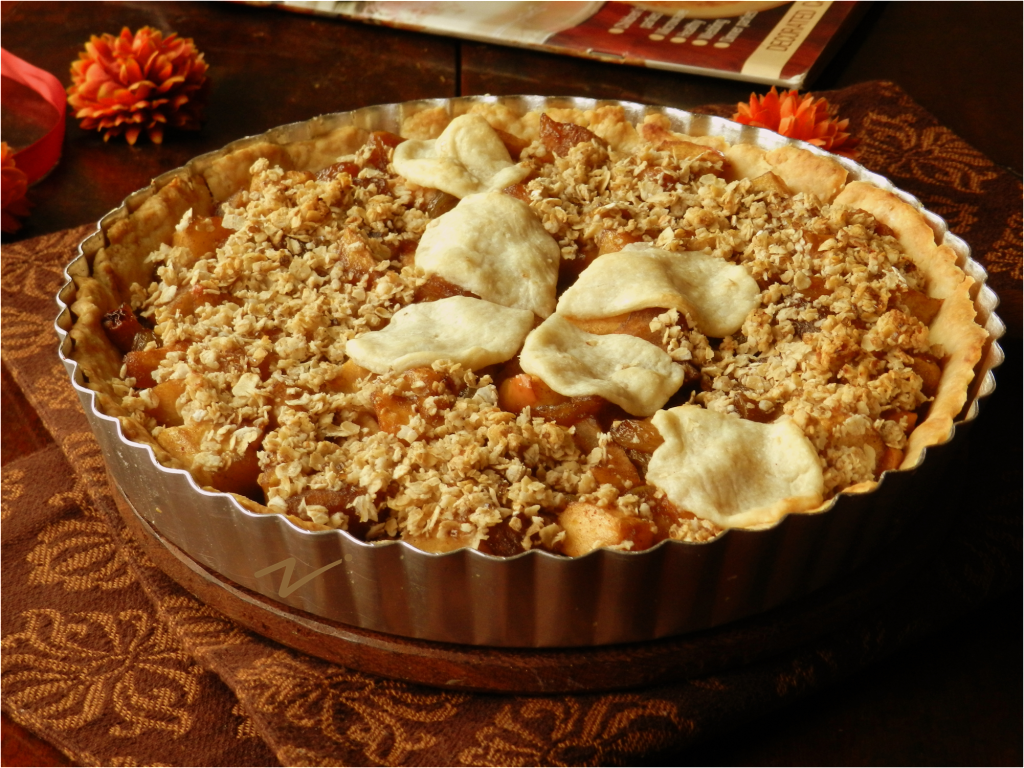And then there is the Tarte Tartin, which is a upside down tart. The apple slices are arranged in concentric circles and fully caramelized in butter and sugar in a pan over gas stove. It is then covered with shortcrust pastry on top and put to bake in the same pan.
Tarte aux Pomme or Apple Tart
Ethnicity – French
For tart base (shortcrust pastry)
- Plain flour (maida – 200 gms)
- Butter (unsalted & chilled – 100 gms)
- Salt – ½ tsp
- Castor sugar – 1 to 2 tsp
- Ice cold water – ¼ cup (approx)
For apple filling
- Apples – 3 big or 4 medium
- Brown sugar – 3 tbsp
- Cinnamon powder -1/2 tsp
- Lemon juice (freshly squeezed – 1 ½ tbsp)
- Lemon zest – ½ tsp
- Raisins – 3 tbsp
- Corn flour – 2 tsp
- Butter – 2 tsp
- Water – about ¼ to 1/2 cup
For crumble topping
- Plain flour – ½ cup (approx)
- Demerara sugar – 2 ½ tbsp
- Chilled & chopped butter – 4 tbsp
- Oats (quaker, quick cooking – ¼ cup)
For the tart base
- Chop the chilled butter and keep on fridge again to chill till you sift the flour.
- Sift together plain flour, sugar, salt in a bowl. Add the chopped chilled butter and rub into the flour with fingertips gently until it resembles breadcrumbs i.e pea sized pieces of butter remain.
- This process of mixing butter into flour can also be done in a food processor. Blend at low speed intermittently (not continuous) till mixture turns crumbly. Then transfer to a mixing bowl.
- Now make a well in the center of the crumbly flour-butter mixture add 1 tbsp water and knead lightly and quickly just until the dough holds together, adding more ice cold water only if necessary. Water should be added 1 tbsp at a time. It is important to work quickly to incorporated all the ingredients into a dough so that butter does not melt/ soften too much because of warm fingers.
- When kneading to a dough, crush any big lumps of butter if any with the heel of your hand and press them back into the dough to combine. Do not add too much liquid, else dough will be sticky and tough. Do not overwork the dough.
- Gather the just formed dough together and form into a thick disk (flatten very slightly). Wrap with cling film and refrigerate for minimum 30 mins or maximum 24 hours.
- At the time of blind baking the base, grease a 8 to 9” tart tin.
- Roll out the chilled dough between 2 cling film sheets to 1/8 inch thickness and slightly larger in diameter than the tart tin.
- Transfer rolled out dough onto greased tart tin with help of rolling pin. Using your fingertips gently press the dough into the tin to make a neat fit. Pinch off any excess dough around the edges to neaten.
- Refrigerate the base for 15 to 30 mins to chill again.
- Preheat oven at 180 C for 10 mins.
- Remove base & prick all over to prevent it from puffing up. Then blind bake (to bake the base alone without the filling) for 15 mins or till very light golden.
- Remove and cool slightly.
For the filling
- Wash, peel apples and cut into dices. Sprinkle with lemon juice to prevent from darkening.
- Transfer all the ingredients for filling, except butter and corn flour, into a saucepan and cook over low heat till just soft, about 10 mins or so.
- Remove from heat and cool a bit. Then add in the corn flour and butter, stir once.
For crumble topping
- Mix together flour, oats, demerara sugar. Add chopped, chilled butter and mix with fingertips or fork till it resembles breadcrumbs/ is crumbly. Do not overmix as the butter might melt.
Proceed
- Pour the apple filling onto the tart base and spread to cover the base evenly. Sprinkle the crumble topping all over the top.
- Bake in preheated oven at 180 C for 15 to 20 mins till top is golden.
- Serve warm or at room temperature, sliced with some crème anglaise or whipped cream or vanilla custard, ice cream or as is.
- Store leftovers in refrigerator for upto a day. May microwave before serving or serve chilled!
As there were some bits of the base remaining, I rolled them out and cut into leaf shapes and kept few on the top alongside crumble topping & baked. This is optional.
If you want to do lattice work on top instead of crumble, use 250 gms flour (instead of 200 gms) & 125 gms chilled butter for the base. Keep ¼ of the dough aside. Roll out remaining for base and fit into the tin. Roll out ¼ th portion, cut into strips (or any shape desired) and do lattice design (or any design desired) on top after keeping the filling. Brush with little milk and bake till top is golden (180 C for 15 to 20 mins).
Evaluating the success of your tart base :
1. When rolling out dough, small pieces of butter should be visible for a flaky tart baked base. If the butter pieces are too large, fold the dough several times and roll it our again. Too large pieces of butter will form holes when baking base. Also, overworked dough will be too elastic.
If no small butter pieces are visible, it means the dough was overworked and the butter has melted into the dough. So the baked pastry will not be flaky.
2. If the dough is too crumbly and cracks when rolled out, not enough water was added. If the dough is extremely soft even after chilling, too much water wad added.
3. The base/ pastry should be tender and flaky when baked.




